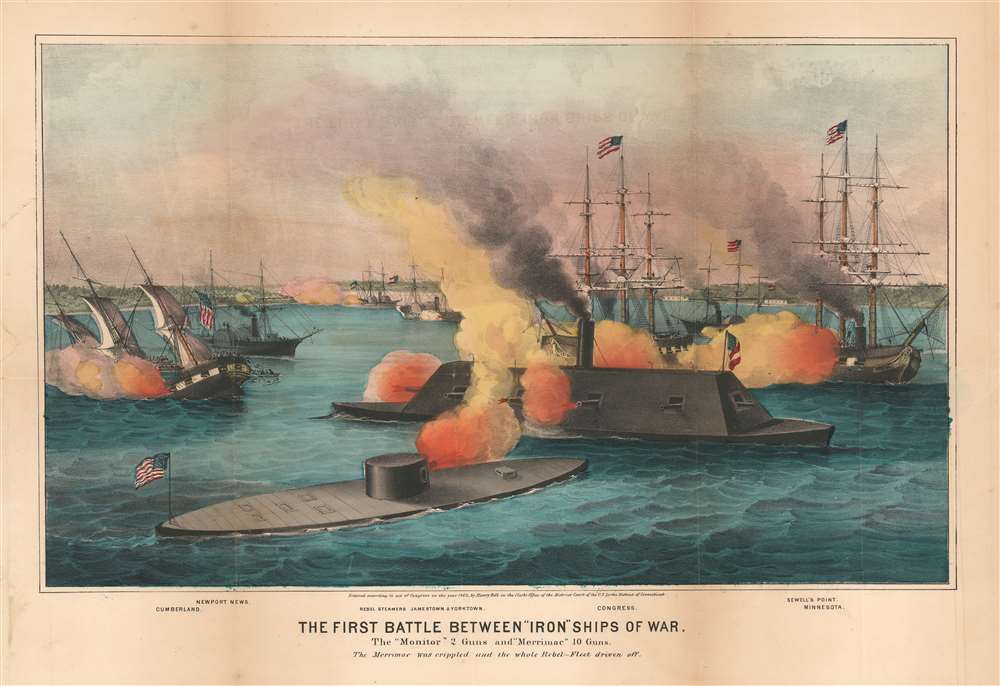This item has been sold, but you can get on the Waitlist to be notified if another example becomes available, or purchase a digital scan.
1862 Bill View of the U.S. Civil War Battle Between the Monitor and Merrimac
IronShips-bill-1862
Title
1862 (dated) 13 x 19 in (33.02 x 48.26 cm)
Description
The USS Cumberland and the USS Congress
Both the Cumberland and the Congress were destroyed by the Virginia during the first day of the battle. The Virginia rammed the Cumberland and she sank rapidly. After this initial success, the captain of the Virginia engaged the Congress. The ships fought and Virginia benefitted from the help of the rest of the James River Squadron. After an hour of unequal combat, the Congress struck her colors and surrendered. In retaliation for being fired upon by a Union shore battery, the captain of the Virginia fired on the Congress with hot shot (red-hot cannonballs). Congress caught fire and burned for the rest of the day and, near midnight, the fire spread to her magazine. This caused an explosion and Congress sank stern first. After dispatching Cumberland and Congress, Virginia moved to engage Minnesota, which had run aground. However, night was falling, and darkness forced Virginia to return to port, granting Minnesota a reprieve.The USS Monitor and the CSS Virginia
The Monitor and the Virginia were not the world's first ironclads, but they were the first to see combat. The Virginia was built on the burnt-out remains of the USS Merrimac, which was inadequately scuttled when the Union evacuated Norfolk's shipyards, hence the Virginia is also referred to as the Merrimac. The Monitor was built from scratch as an ironclad in Greenpoint, Brooklyn. Monitor was dispatched to Hampton Roads to defend the Minnesota against the Virginia. Monitor engaged Virginia on the morning of March 9, 1862, when Virginia moved to destroy the Minnesota. Monitor and Virginia fought for hours at close range and neither were able to beat the other. Virginia had not expected to encounter another ironclad, so she was not armed with iron-piercing ammunition. Monitor was armed with guns large enough to pierce Virginia's armor, but the shipbuilder feared that using thirty-pound charges could damage the ship, so only fifteen-pound charges were used. The battle ended after a shell from Virginia hit Monitor's pilot house and temporarily blinded its captain, forcing her to temporarily disengage. Virginia's captain believed that the Monitor disengaged because she was leaving the battle and elected to head back to port to undergo repairs. When Monitor returned to the battle and saw Virginia withdrawing, they erroneously believed she had given up. Thus, both ship's captain's declared victory.The View as Propaganda
Since the reality of the battle does not reflect the statement made here, that 'The Merrimac was crippled and the whole Rebel-Fleet driven off', this view celebrates a victory that was in fact a stalemate. Both sides declared victory. The Confederate Secretary of the Navy lauded the performance of the Virginia and the other vessels in a letter to Confederate President Jefferson Davis, while the crew of the Monitor received the official thanks of Congress and Quartermaster Peter Williams was awarded the Medal of Honor.Chromolithography
Chromolithography is a color lithographic technique developed in the mid-19th century. The process involved using multiple lithographic stones, one for each color, to yield a rich composite effect. Oftentimes, the process would start with a black basecoat upon which subsequent colors were layered. Some chromolithographs used 30 or more separate lithographic stones to achieve the desired effect. Chromolithograph color could also be effectively blended for even more dramatic results. The process became extremely popular in the late 19th and early 20th centuries, when it emerged as the dominate method of color printing. The vivid color chromolithography produced made it exceptionally effective for advertising and propaganda imagery.Publication History and Census
This view was created and published by Henry Bill in 1862. Two examples are cataloged in OCLC and are part of the institutional collections at the Library of Congress and the Boston Athenaeum.Cartographer
Henry Bill (May 18, 1824 - August 14, 1891) was an American book publisher. Born in Groton (now Ledyard), Connecticut to Lucy and Burdon Bill, Henry attended the academy in Plainfield as a boy. After graduation, Bill taught in Groton and Plainfield until, at the age of twenty, a relative, James A. Bill, offered him a job in Philadelphia workin for the book publishing business he owned. Bill spend the next three years learning the publishing business and selling books door to door in the western states. Then, in 1847, Bill moved to Norwich where he opened his own publishing firm. The elder of the Harper Brothers of New York recognized his skill and gave Bill support and an unlimited line of credit. Over the following twenty-five years, Bill's publishing company produced hundreds of thousands of books and by 1865 was among the sixty wealthiest men in Norwich. When faced with failing health and the prospect of retirement, Bill converted his business into a joint-stock company, creating the Henry Bill Publishing Company, which continued to flourish for years. Bill was also involved in politics, serving as a member of the State Senate in 1853. As a member of the Democratic Party, when the party split in 1856, he chose the anti-slavery group, and became an active member of the fledgling Republican Party. Bill was also very successful with his real estate investments and was also one of the founders of Chelsea Savings Bank, serving as the bank's vice president from 1858 until 1882. Bill married Julia O. Chapman on February 10, 1847, with whom he had seven children. More by this mapmaker...

